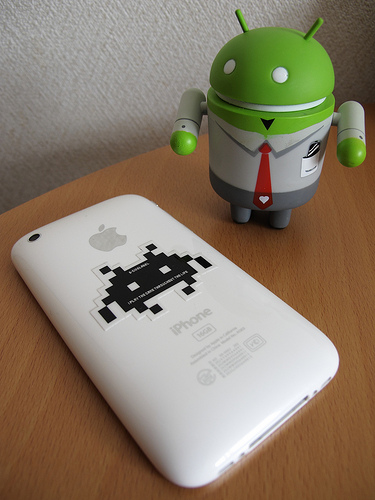There’s no denying that Android OS has taken over the mobile arena, with up to 50% of all tablets, smartphones and other mobile devices to be using variants of the Android OS. The more exclusive iPhone with its trademark iOS from Apple follows at 30% of that number.

Interface
First time smartphone owners will appreciate the easy navigability of the Apple interface—colorful icons set in rows of four on the screen. Everything is conveniently accessible at one swipe of the finger, and this is one of the iOS’ strong points.
On the other hand, Android may have more to offer in terms of interface. For instance, there’s a lot more you can do on the menu of a Samsung Galaxy SII than on an iPhone, allowing you to tweak settings at the same time from the menu, which is something you can also do on HTC Sense phones. Widgets on the Google OS, for instance, are so customizable that each user may have completely different experiences of the interface.
Still, simplicity may win more followers for Apple’s iOS, as Android can be confusing to non-aficionados.
Multitasking
It’s extremely easy to perform several functions at once on iOS. Simply double-press the home button and swipe from left to right. You can shut down applications without having to open them again on your screen by just pressing the X on the icon.
On the other hand, Android’s relatively complex interface allows you to view all running applications at once, but you can’t close them from a central location like in iOS. The latest Ice Cream Sandwich OS will offer a better multitasking function, but for now, it seems Apple has got the upper hand on this one.
Keyboard
The iPhone’s touch screen keypad is relatively accurate and works either for portrait or landscape mode, depending on your preference. Android phones have different typing reviews, depending largely on the specific model. HTC seems to have the best reviews when it comes to typing.
Camera
Apple has taken quite a leap with its camera feature on its iPhone 4S, featuring an 8 megapixel camera and fun related apps like Instagram. Still, Android has more to offer in that arena, as Android phones have several extra features that Apple cannot pull off, like HDR, color burst and a better flash.
Apps
While Apple may have had the upper hand over Android over the last few years, Android has finally gained some substantial ground over the number of iOS apps. Apple has currently 360,000 apps for its iOS, with Android at 320,000 apps—not far behind when you think about how far they’ve come. Android has also created versions of popular iOS apps that are compatible for Android phones, such as Kindle and Angry Birds.
However, Apple still has the same edge over Android in this area, most notably because of its selection of high-quality apps.
***
While it might seem like a battle that’s been waging for the longest time now, the decision between the two doesn’t have to be very hard. The trick to deciding between an Android phone and an iPhone is to determine first what you want out of a smartphone.
About the Author:
Amy C. is an avid techie enthusiast who likes writing about the latest in mobile technology. When she’s not researching the latest software releases of both Android and Apple, she spends time working for Greyside Group, a maritime security and executive protection company, specifically in its office administration and blogging activities. To learn more about Amy’s take on everything techie, stay tuned for her next post.
Image credit
